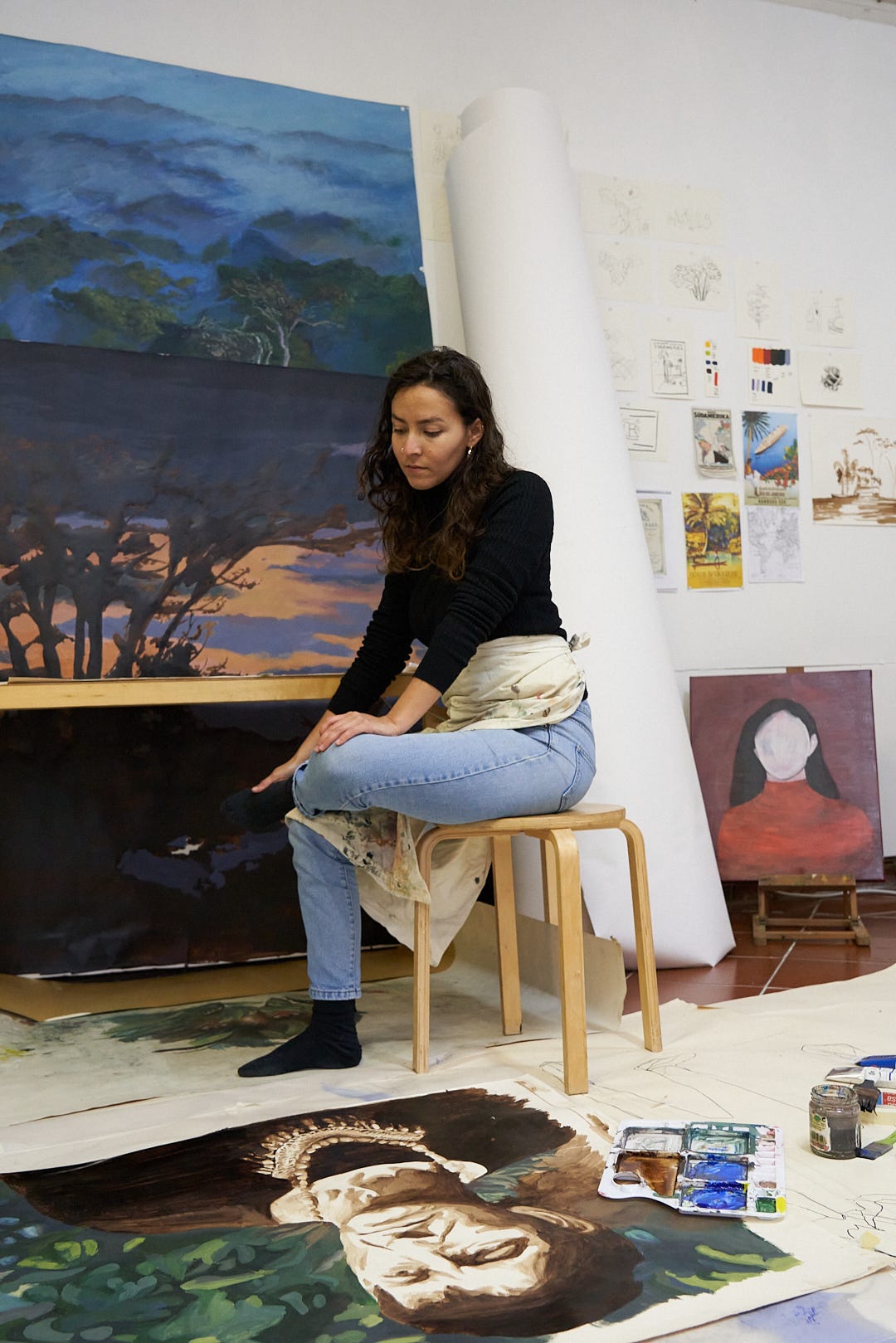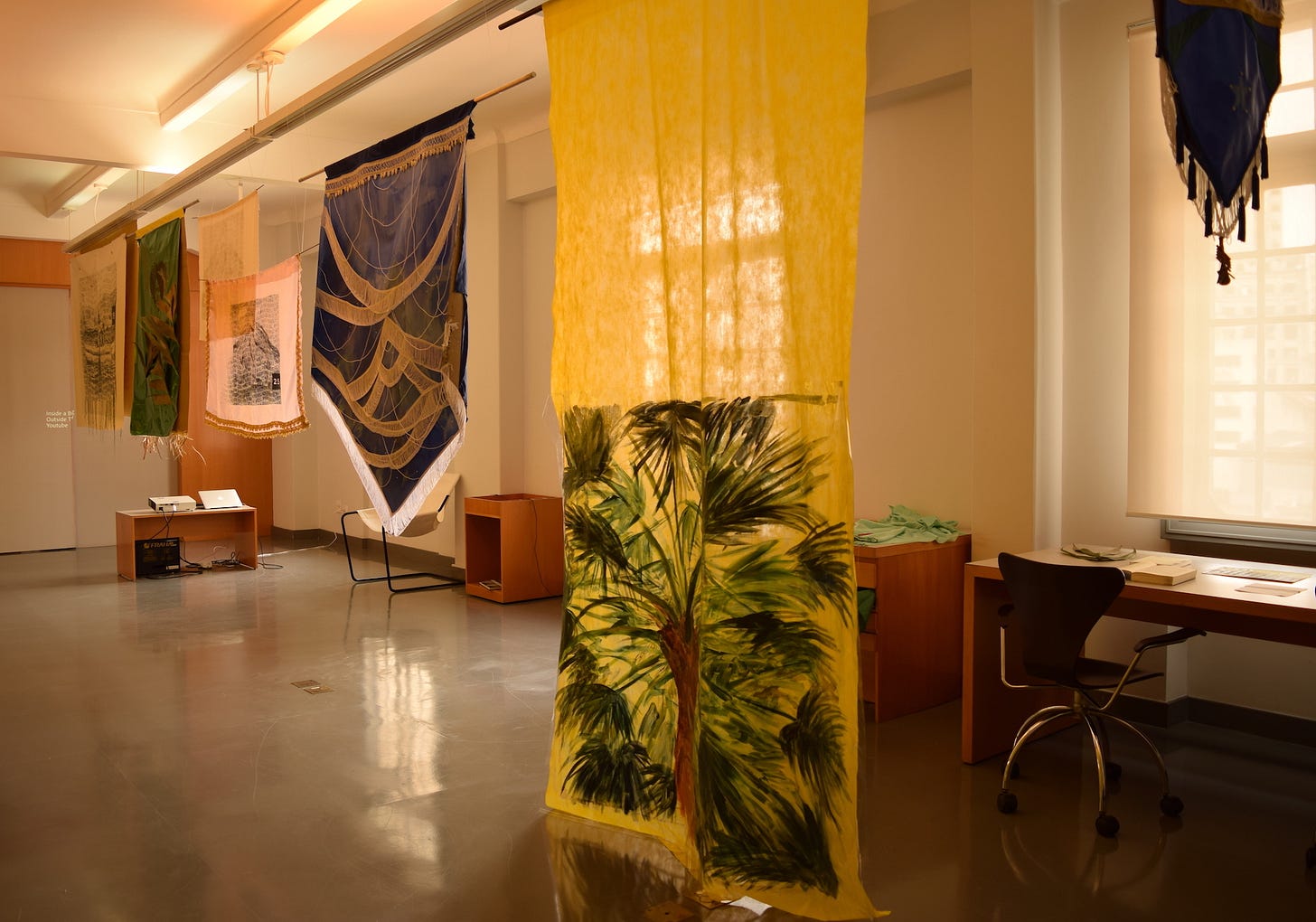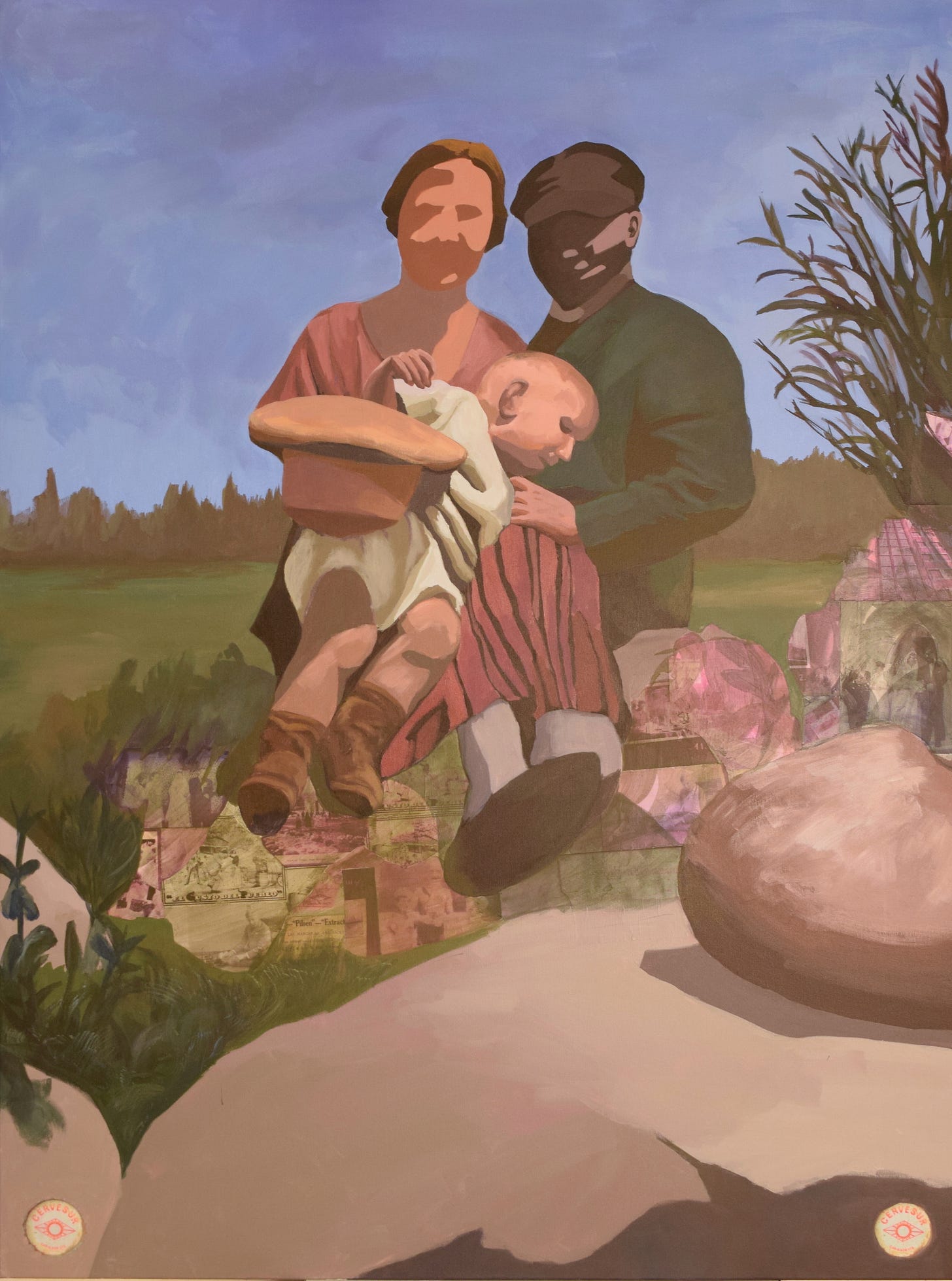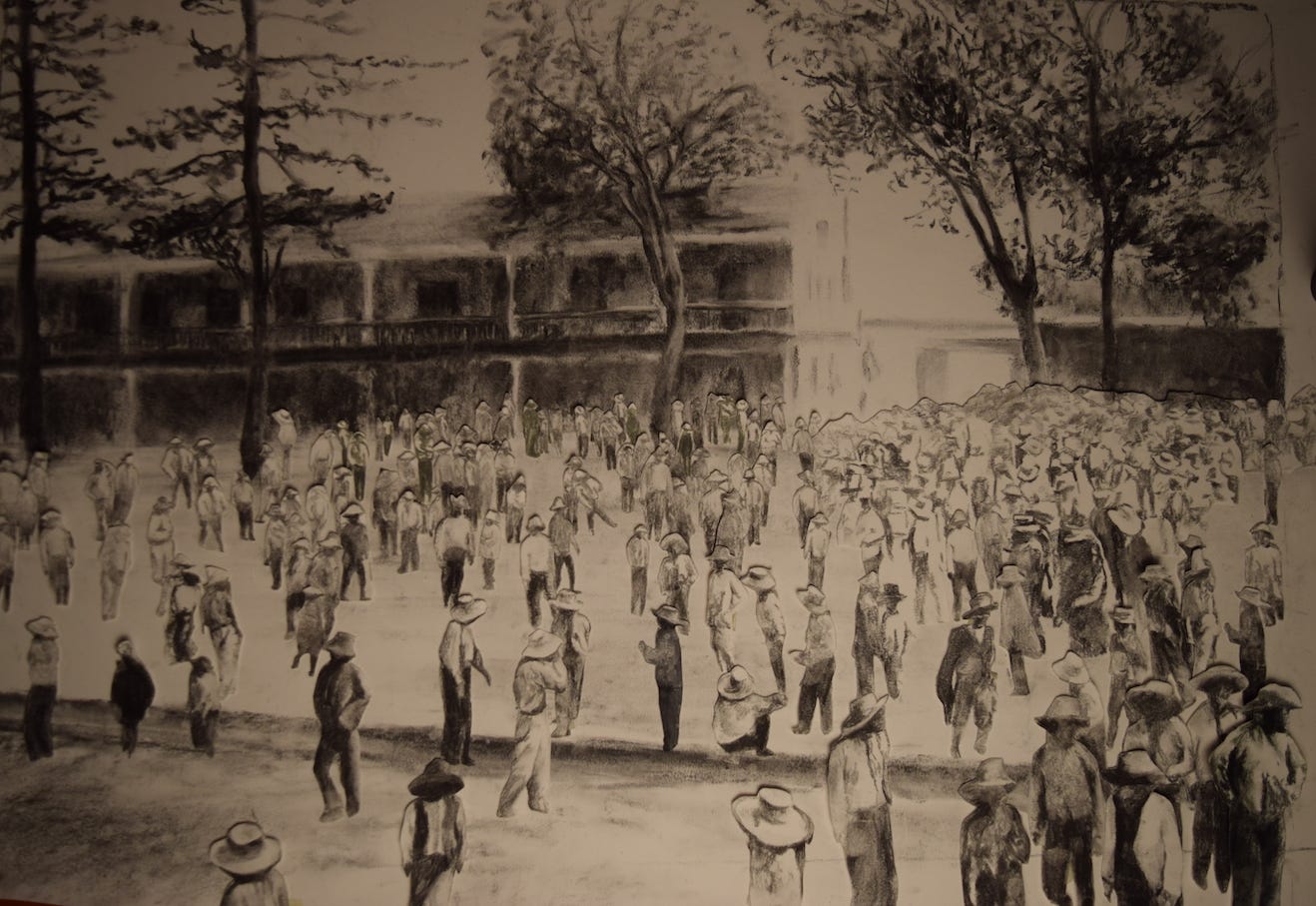In the Studio with: Helga Elsner Torres
En el Estudio con: Helga Elsner Torres (versión en español abajo)
Helga Elsner Torres is an artist of Peruvian-German origin currently based in Berlin, Germany.
Her work frequently addresses themes of identity preservation and construction, as well as migration, particularly from a North to Global South perspective. She also explores eco-social issues, such as oil spills in the Peruvian Amazon, having collaborated with other renowned artists in the field, such as Tomás Saraceno in his project “Aerocene.”
In this interview, Helga talks about her inspiration, her work, how her experiences have shaped her art and her recent participation in her first artist residency at the Armando Álvares Penteado Foundation (FAAP) in São Paulo, Brazil.
Q: How did your interest in art begin?
Helga Elsner Torres: Since I was a child, I always drew a lot. My parents were architects, my mother even studied sculpture for a while, so an easel and watercolors were always within my reach. During my teenage years, I faced difficult times, and drawing accompanied me. Before I finished high school, I knew I wanted to study painting. So I enrolled in an art faculty in Lima, eager to learn. What motivated me most at that stage was seeing the work of the older students, the large formats, and thinking that someday I would have my own studio at the university.
Art turned out to be much more than I thought: a language with which you can talk about your life, your dreams, your past, politics, society. That changed everything for me. It was a time of much experimentation, of learning techniques and devouring art books. However, before I finished my degree, I wanted to see what else was outside my context, to explore international art and meet more diverse artists, especially more women in the art scene. I decided to move to Germany, where I studied a master's degree at the Berlin University of the Arts, specializing in Public Interest Art. There I had the opportunity to learn from colleagues from various parts of the world, who came from as far away as I did, which opened my mind to new realities.
My art became more focused on issues of public opinion and diverse communities. During that time, I became more interdisciplinary, exploring new forms of expression such as my first publication and my first short film, which gave me new tools, besides painting, to communicate as an artist.
“Art turned out to be much more than I thought: a language with which you can talk about your life, your dreams, your past, politics, society”
Q: How did your own history of migration to Germany influence your artistic expression?
Helga Elsner Torres: The first time I visited Germany and went to museums, I noticed that the works exhibited were similar to my style, which led me to question why I painted that way, having experiences and coming from totally different places.
In Peru, the art faculty at my university was founded by an Austrian, and I began to wonder why the teaching patterns, techniques and examples were so European. I intentionally moved away from that and began to create darker paintings with touches of color, often touching on themes related to the Amazon and oil spills. My maternal family is from Moyobamba, a city in the Peruvian jungle, so those themes resonated with me.
Q: In your project “Wo kommst du (wirklich) her?” (Where do you (really) come from?), you address the topic of migration in more depth. Can you tell us more about it?
Helga Elsner Torres: My project “Wo kommst du (wirklich) her?” (Where do you (really) come from?) was actually born after I made my first short film “Tace, ora et labora” (“Shut up, pray and work”). It is about German landowners who arrived in northern Peru in the 19th century and who, organized among themselves, illegally trafficked Peruvian archaeological objects and human remains to Germany.
The research for this short film began after the construction of the Humboldt Forum Museum in Berlin, where ancient Peruvian archaeological objects are exhibited and there was a collection of the descendants of my great-grandfather's German employer. From there, I started researching about my own past and about my paternal great-grandfather, who was German. In the process, I met migrants like myself in Germany who shared similar family histories. This led me to want to delve deeper into the history of German migration to Peru, also exploring its most critical aspects through personal accounts. In the case of Spain, in Peru we have a clearer context about how that migration affected us, but little is known about German migration to Peru and South America in general. Current migration is often viewed as a movement of people from the Global South to the Global North, yet the impacts of migration in the opposite direction are rarely discussed. Thus this project was born, in which I combined painting with archives and testimonies of German descendants who participated in the project.
One day, while researching family constellations, I realized that in reality, all the members of my family are migrants. My parents moved to Lima, the capital, leaving behind their hometowns in the provinces. As a child, I did not perceive it so much, but as I grew up I understood how complicated it must have been for them to make that change. Migrating to another country is difficult, but being from the same country and moving to another city within the same country, where they speak the same language but perceive you differently, is also a challenge.
“Current migration is often viewed as a movement of people from the Global South to the Global North, yet the impacts of migration in the opposite direction are rarely discussed”
Q: What other sources of inspiration do you draw from?
Helga Elsner Torres: From music and food. Both aspects are closely related to the formation and preservation of identity. I am interested in how different cultures and migratory waves influence the gastronomy of different countries.
I am also fascinated by the mixture of languages, such as “portuñol” or Spanish with some alterations of German verbs, which we emigrants living in Germany use. There is even a museum in São Paulo that deals with this topic: the Museum of the Portuguese Language. They told me about their approach, and I found it interesting how they consider the language as a living thing that is constantly changing, influenced by emigrants who introduce new words and mannerisms.
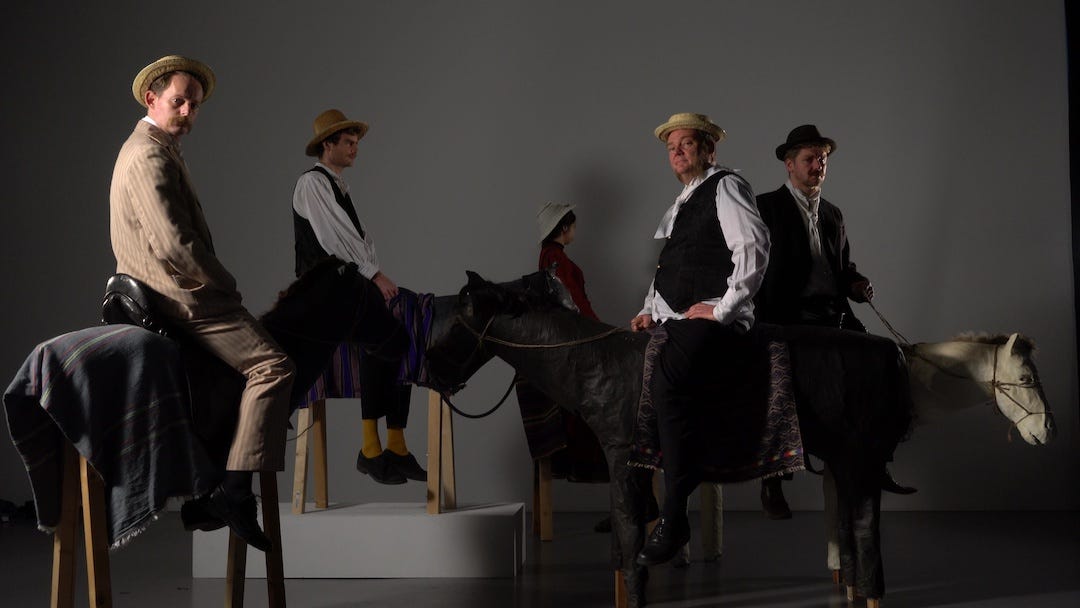
Q: What is your interest in the materials you use and do they have any special connotation?
Helga Elsner Torres: During my last years of university in Peru, I got intoxicated working with oil. After getting involved in oil spill projects, I decided it was necessary to change the materials I use for something more ecological and coherent with the themes I address. I found an ink called “nogalina”, which is exactly petroleum colored but comes from walnut shells. It was a coincidence. But, currently my work is more focused on intervened painting and canvases, since I love large formats and this type of material is easier to transport.
“After getting involved in oil spill projects, I decided it was necessary to change the materials I use for something more ecological and coherent with the themes I address”
Q: One of your projects related to oil spills was a collaboration with artist Tomás Saraceno, in his “Aerocene” initiative. What was that experience like?
Helga Elsner Torres: I was very concerned about oil spills, especially because they happen a lot in the Peruvian Amazon.
In 2015, I visited the community of Cuninico, affected by a spill of more than 2,300 barrels of oil. To this day, the community is still suffering social, environmental and economic damages due to this disaster. Within this context, I collaborated with Tomás Saraceno in his project “Aerocene”, a movement for eco-social justice. The initiative consisted of creating floating sculptures made of reused plastic, which function in an aerostatic way. The idea was that the community could use them to take aerial photographs as evidence to strengthen their advocacy against the companies responsible for the spills.
Working with him and his team was an enriching experience, especially because I am interested in collective work and dialogues between artists.
Q: We know that you have just returned from your first artistic residency: FAAP in São Paulo. What was your proposal about?
Helga Elsner Torres: My proposal was about getting in touch with people in the public space, in the form of interviews, touching on the theme of identities. That is, starting from national symbols: how much people feel identified with them.
As São Paulo is a city that has several different communities living together in the same space, I thought and still think that it is a place where I can learn a lot by talking to its people. From these results, I created my work. In the end, I did not conduct the interviews, but had several more casual or natural encounters and conversations, in places that I did not expect, such as “rodas de samba”, street concerts, walks in the historic center of the city or surfing in the sea. Much of the work was based on the observation of symbols present in passports, banknotes and coins; but also on Brazilian popular music and its meanings. In the end I painted pictures, sewed them by hand and machine, added perishable and local materials such as carnauba straw, which, for example, comes from the Brazilian northeast, but is very present.
For me, it was fundamental to explore these identities that coexist in Brazil: these experiences are like “layers” of identity that are part of a person. They are not stable, but change and are influenced by where one grows up, when one migrates to a different place or by the cultural influences that are part of one's own family, for example. I was interested in delving into this topic there, given that it has been a former colony and also the scene of numerous migratory waves. In addition, I felt a great interest in visiting the country, since my great-grandfather landed in Brazil from Germany, before arriving and settling in Peru.
Another important motivation for this residency was to meet other artists. I wanted to experience a new environment and collaborate, share realities and learn from them. I really like to get out of my comfort zone and experience new situations.
“For me, it was fundamental to explore these identities that coexist in Brazil: these experiences are like “layers” of identity that are part of a person. They are not stable, but change and are influenced by where one grows up, when one migrates to a different place or by the cultural influences that are part of one's own family…”
Q: What does art mean to you?
Helga Elsner Torres: For me, art means creating relationships and leaving a legacy that transcends my own existence. As a way to build something that will remain for the rest of the people. Through art, I seek to establish connections with others and generate a new system of communication.
“For me, art means creating relationships and leaving a legacy that transcends my own existence”
Q: How do you hope your art will contribute to the legacy of migration stories?
Helga Elsner Torres: I try to create art in collaboration with the communities I belong to. For me, it is critical to respect and amplify the voices of those who are part of these stories. More than speaking on their behalf, my intention is to accompany, support and generate spaces where they can share their own experiences, acknowledging their own voice and perspectives.
“I try to create art in collaboration with the communities I belong to. More than speaking on their behalf, my intention is to accompany, support and generate spaces where they can share their own experiences, acknowledging their own voices and perspectives”
To learn more about Helga Elsner Torres, visit:
Helga Elsner Torres es una artista de origen peruano-alemán que reside actualmente en Berlín, Alemania.
Su obra frecuentemente aborda cuestiones de preservación y construcción de la identidad, así como la migración, particularmente desde una perspectiva del Norte hacia el Sur Global. También explora temas eco-sociales, como los derrames de petróleo en la Amazonía peruana, habiendo colaborado con otros reconocidos artistas en el ámbito, como Tomás Saraceno en su proyecto “Aerocene.”
En esta entrevista, Helga nos habla sobre su inspiración, su obra, cómo sus experiencias han moldeado su arte y su reciente vivencia en su primera residencia artística en la Fundación Armando Álvares Penteado (FAAP) en São Paulo, Brasil.
P: ¿Cómo comenzó tu interés por el arte?
Helga Elsner Torres: Desde pequeña, siempre dibujé mucho. Mis padres fueron arquitectos, mi madre incluso estudió escultura por un tiempo, por lo que un caballete y acuarelas siempre estuvieron a mi alcance. Durante mi adolescencia, enfrenté momentos difíciles, y el dibujo me acompañó. Antes de terminar la secundaria, sabía que quería estudiar pintura. Así que ingresé a la Facultad de Arte en Lima, con ganas de aprender. Lo que más me motivó en esa etapa fue ver el trabajo de los estudiantes mayores, los grandes formatos, y pensar que algún día tendría mi propio taller en la universidad.
El arte resultó ser mucho más de lo que yo pensaba: un lenguaje con el que puedes hablar de tu vida, tus sueños, tu pasado, de política, de la sociedad. Eso cambió todo para mí. Fue un tiempo de mucha experimentación, de aprender técnicas y devorar libros de arte. Sin embargo, antes de terminar la carrera, quise ver qué más había fuera de mi contexto, explorar el arte internacional y conocer a artistas más diversos, especialmente más presencia de mujeres en la escena artística. Decidí mudarme a Alemania, donde estudié una maestría en la Universidad de las Artes de Berlín, especializándome en Arte de interés público. Ahí tuve la oportunidad de aprender de colegas de varias partes del mundo, que venían de tan lejos como yo, lo que abrió mi mente a nuevas realidades.
Mi arte se enfocó más en temas de opinión pública y diversas comunidades. Durante ese tiempo, me volví más interdisciplinaria, explorando nuevas formas de expresión como mi primera publicación y mi primer cortometraje, lo que me brindó nuevas herramientas, además de la pintura, para comunicarme como artista.
“El arte resultó ser mucho más de lo que yo pensaba: un lenguaje con el que puedes hablar de tu vida, tus sueños, tu pasado, de política, de la sociedad”
P: ¿Cómo influyó tu propia historia de migración a Alemania en tu expresión artística?
Helga Elsner Torres: La primera vez que visité Alemania y fui a museos, noté que las obras exhibidas eran similares a mi estilo, lo que me llevó a cuestionar por qué pintaba yo de esa manera, teniendo experiencias y viniendo de lugares totalmente diferentes.
En Perú, la facultad de arte de mi universidad fue fundada por un austriaco, y empecé a preguntarme por qué los patrones de enseñanza, las técnicas y los ejemplos eran tan europeos. Intencionalmente, me alejé de eso y comencé a crear pinturas más oscuras con toques de color, a menudo tocando temas relacionados con la Amazonía y los derrames de petróleo. Mi familia materna es de Moyobamba, una ciudad en la selva peruana, entonces esos temas resonaban conmigo.
P: En tu proyecto “Wo kommst du (wirklich) her?” (¿De dónde vienes (realmente)?), abordas más a fondo el tema de la migración. ¿Puedes hablarnos más de él?
Helga Elsner Torres: Mi proyecto “Wo kommst du (wirklich) her?” (¿De dónde vienes (realmente)?) nace en realidad después de realizar mi primer cortometraje “Tace, ora et labora” (“Calla, reza y trabaja”). Este trata de hacendados alemanes que llegaron al norte de Perú en el siglo XIX y que, organizados entre sí, traficaron ilegalmente objetos arqueológicos y restos humanos peruanos hacia Alemania.
La investigación para este cortometraje comenzó tras la construcción del Museo Humboldt Forum en Berlín, donde se exhiben objetos arqueológicos peruanos antiguos y había una colección de los descendientes del empleador alemán de mi bisabuelo. A partir de ahí, empecé a investigar sobre mi propio pasado y sobre este bisabuelo paterno, quien fue alemán. En el proceso, conocí a personas migrantes como yo en Alemania, que compartían historias familiares similares. Esto me llevó a querer profundizar en la historia de la migración alemana a Perú, explorando también sus aspectos más críticos a través de relatos personales. En el caso de España, en Perú tenemos un contexto más claro sobre cómo nos afectó esa migración, pero se sabe poco sobre la migración alemana hacia Perú y Sudamérica en general. A menudo, la migración actual se asocia con un movimiento de personas del Sur Global al Norte Global, pero rara vez se habla de las consecuencias de la migración en la dirección opuesta. Así nació este proyecto, en el que combiné pintura con archivos y testimonios de descendientes de alemanes que participaron en el proyecto.
Un día, mientras investigaba sobre constelaciones familiares, me di cuenta de que en realidad, todos los miembros de mi familia somos migrantes. Mis padres se mudaron a Lima, la capital, dejando atrás sus ciudades de origen en provincia. De niña, no lo percibía tanto, pero al crecer comprendí lo complicado que debió ser para ellos realizar ese cambio. Migrar a otro país es difícil, pero ser del mismo país y mudarte a otra ciudad dentro del mismo, donde hablan el mismo idioma pero te perciben diferente, también es un desafío.
“A menudo, la migración actual se asocia con un movimiento de personas del Sur Global al Norte Global, pero rara vez se habla de las consecuencias de la migración en la dirección opuesta.”
P: ¿De que otros lugares provienen tu inspiración?
Helga Elsner Torres: De la música y la comida. Ambos aspectos están estrechamente relacionados con la formación y preservación de la identidad. Me interesa cómo las diferentes culturas y olas migratorias influyen en la gastronomía de diversos países.
También me fascina la mezcla de idiomas, como el “portuñol” o el castellano con algunas alteraciones de verbos alemanes, que utilizamos los migrantes que vivimos en Alemania. Incluso hay un museo en São Paulo que aborda esta temática: el Museo de la Lengua Portuguesa. Me contaron sobre su enfoque, y me pareció interesante cómo consideran el lenguaje como algo vivo que cambia constantemente, influenciado por los migrantes que introducen nuevas palabras y manerismos.
P: ¿Cuál es tu interés en los materiales que utilizas? ¿Tienen alguna connotación especial?
Helga Elsner Torres: Durante mis últimos años en la universidad en Perú, me intoxiqué por trabajar con óleo. Después de involucrarme en proyectos sobre derrames de petróleo, decidí que era necesario cambiar los materiales que uso por algo más ecológico y coherente con los temas que abordo. Encontré una tinta llamada nogalina, que es exactamente de color petróleo pero proviene de la cáscara de la nuez. Fue una coincidencia. Pero, actualmente mi trabajo se centra más en pintura intervenida y las telas, ya que me encantan los formatos grandes y este tipo de material es más fácil de transportar.
“Después de involucrarme en proyectos sobre derrames de petróleo, decidí que era necesario cambiar los materiales que uso por algo más ecológico y coherente con los temas que abordo”
P: Uno de tus proyectos relacionados con los derrames de petróleo fue una colaboración con el artista Tomás Saraceno, en su iniciativa “Aerocene”. ¿Cómo fue esa experiencia?
Helga Elsner Torres: Me preocupaban mucho los derrames de petróleo, especialmente porque suceden mucho en la Amazonía peruana.
En el 2015, visité la comunidad de Cuninico, afectada por un derrame de más de 2,300 barriles de petróleo. Hasta hoy, la comunidad sigue sufriendo daños sociales, ambientales y económicos debido a este desastre. Dentro de este contexto, colaboré con Tomás Saraceno en su proyecto “Aerocene”, un movimiento por la justicia eco-social. La iniciativa consistía en crear esculturas flotantes hechas de plástico reutilizado, que funcionan de manera aerostática. La idea era que la comunidad pudiera usarlas para tomar fotografías aéreas como evidencia y así fortalecer su defensa ante las empresas responsables de los derrames.
Trabajar con él y su equipo fue una experiencia enriquecedora, especialmente porque me interesa el trabajo colectivo y los diálogos entre artistas.
P: Sabemos que acabas de regresar de tu primera residencia artística: FAAP en São Paulo. ¿De qué trató tu propuesta?
Helga Elsner Torres: Mi propuesta trató de entrar en contacto con personas en el espacio público, a manera de entrevistas, tocando el tema de identidades. Es decir, partiendo de los símbolos nacionales: qué tanto las personas se sienten identificados con ellos.
Como São Paulo es una ciudad que tiene varias comunidades diferentes conviviendo en el mismo espacio, pensé y sigo pensando que es un lugar de donde yo puedo aprender mucho hablando con su gente. A partir de esos resultados, crear mi obra. Al final, no realicé las entrevistas, sino tuve varios encuentros y conversaciones más casuales o naturales, en lugares que no me lo esperaba como “rodas de samba”, conciertos en la calle, caminatas en el centro histórico de la ciudad o en el mar surfeando. Mucha de la obra sí se basó en la observación de símbolos presentes en los pasaportes, billetes y monedas; pero también en la música popular brasileña y sus significados. Al final pinté cuadros, los cosí a mano y a máquina, les agregué materiales perecibles y locales como paja de carnauba, que, por ejemplo, viene del nordeste brasileño, pero está muy presente.
Para mí, era fundamental explorar estas identidades que conviven en Brasil: Estas experiencias son como “capas” de identidad que forman parte de una persona. No son estables, sino cambian y se influyen por el lugar de donde crece, cuando una migra a otro lugar diferente o por las influencias culturales que forman parte de la propia familia, por ejemplo. Me interesaba profundizar en este tema allá, dado que ha sido ex-colonia y también escenario de numerosas oleadas migratorias. Además, sentía un gran interés por visitar el país, ya que mi bisabuelo desembarcó en Brasil de Alemania, antes de llegar y establecerse en Perú.
Otra motivación importante para esta residencia fue conocer a otros artistas. Quería experimentar un nuevo ambiente y colaborar, compartir realidades y aprender de ellos. Me gusta mucho salir de mi zona de confort y experimentar situaciones nuevas.
“Para mí, era fundamental explorar estas identidades que conviven en Brasil: Estas experiencias son como “capas” de identidad que forman parte de una persona. No son estables, sino cambian y se influyen por el lugar de donde crece, cuando una migra a otro lugar diferente o por las influencias culturales que forman parte de la propia familia…”
P: ¿Qué significa el arte para ti?
Helga Elsner Torres: Para mi, el arte significa crear relaciones y dejar un legado que trascienda mi propia existencia. Como una forma de construir algo que permanezca para el resto de personas. A través del arte, busco establecer conexiones con los demás y generar un nuevo sistema de comunicación.
“Para mi, el arte significa crear relaciones y dejar un legado que trascienda mi propia existencia”
P: ¿Cómo esperas que tu arte contribuya al legado de las historias de migración?
Helga Elsner Torres: Intento crear arte en colaboración con las comunidades a las que pertenezco. Para mí, es fundamental respetar y amplificar las voces de quienes forman parte de estas historias. Más que hablar en su nombre, mi intención es acompañar, apoyar y generar espacios donde puedan compartir sus propias experiencias, reconociendo su propia voz y perspectivas.
“Intento crear arte en colaboración con las comunidades a las que pertenezco. Más que hablar en su nombre, mi intención es acompañar, apoyar y generar espacios donde puedan compartir sus propias experiencias, reconociendo sus propias voces y perspectivas”
Para saber más sobre Helga Elsner Torres, visita:





